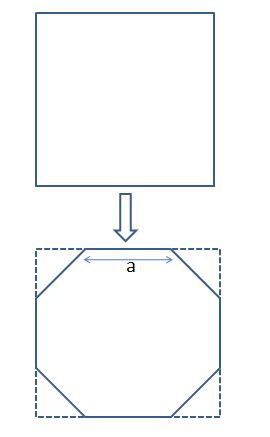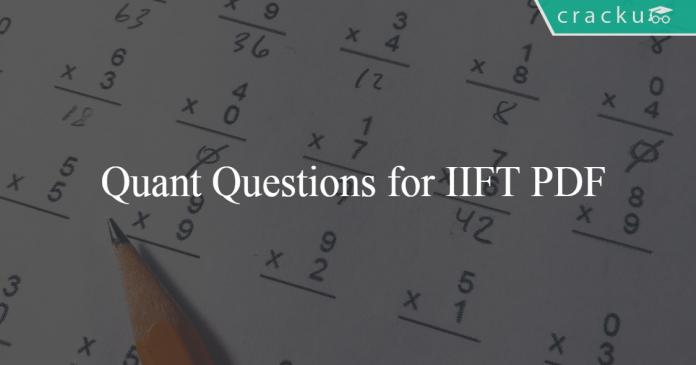Quant Questions for IIFT PDF
Download important IIFT Quant Questions PDF based on previously asked questions in IIFT and other MBA exams. Practice Quant questions and answers puzzles for IIFT exam.
Download Quant Questions for IIFT PDF
IIFT Previous year question papers PDF
Question 1: The square root of $1 + x^2 + \sqrt{1 + x^2 + x^4}$is
a) $\frac{1}{\sqrt2} \left[ \sqrt{1 + x + x^2 } + \sqrt{1 – x + x^2 } \right]$
b) $\frac{1}{\sqrt2} \left[ \sqrt{1 + x + x^2 } – \sqrt{1 – x + x^2 } \right]$
c) $\frac{1}{\sqrt2} \left[ \sqrt{1 + x^2 + x^4 + x^8 }\right] $
d) None of the above
Question 2: The roots of quadratic equation $y^2 -8y + 14$ are $\alpha$ and $\beta$. Find the value of $(1 + \alpha + \beta^2)(1 + \beta + \alpha^2)$
a) $419$
b) $431$
c) $485 + 3\sqrt{22}$
d) $453+ \sqrt{22}$
Question 3: Ram, Ravi and Ratan can alone finish an assignment in 9 days, 12 days and 15 days respectively. They decide to complete a work by working in turns. Ram works alone on Monday, Ravi does the work alone on Tuesday, followed by Ratan working alone on Wednesday & so on. What proportion of the complete work is done by Ravi?
a) 2/9
b) 12/47
c) 1/3
d) 4/9
Question 4: A metallic solid is made up of a solid cylindrical base with a solid cone on its top. The radius of the base of the cone is 5 cm. and the ratio of the height of the cylinder and the cone is 3:2. A cylindrical hole is drilled through the solid with height equal to 2/$3^{rd}$ of the height of solid. What should be the radius (in cm) of the hole so that the volume of the hole is 1/$3^{rd}$ of the volume of the metallic solid after drilling?
a) $\sqrt{\frac{45}{8}}$
b) $\sqrt{\frac{35}{8}}$
c) $\sqrt{\frac{65}{8}}$
d) $\sqrt{\frac{55}{8}}$
Question 5: At the foot of the mountain, the angle of elevation of the summit at the top of the mountain is 45°. After ascending 100 metres, at a slope of 30° up the mountain towards the summit. the angle of elevation of the summit is 60°. Find the height of the summit.
a) $50(\sqrt3 + 1)$metres
b) $50(\sqrt5 + 1)$metres
c) $50(\sqrt3 + 2)$metres
d) $50\sqrt3$metres
Question 6: The sum of the series is:
$\frac{1}{1.2.3}+\frac{1}{3.4.5}+\frac{1}{5.6.7}+…$
a) $e^{2} – 1$
b) $\log_{e}{2}-1$
c) $2\log_{10}{2}-1$
d) None of the above
Question 7: If $\log_{2}{x}.\log_{\frac{x}{64}}{2}=\log_{\frac{x}{16}}{2}$. Then x is
a) 2
b) 4
c) 16
d) 12
Question 8: Mohan was playing with a square cardboard of side 2 metres. While playing, he sliced off the corners of the cardboard in such a manner that a figure having all its sides equal was generated. The area of this eight sided figure is:
a) $\frac{4\sqrt{2}}{(\sqrt{2}+1)}$
b) $\frac{4}{(\sqrt{2}+1)}$
c) $\frac{2\sqrt{2}}{(\sqrt{2}+1)}$
d) $\frac{8}{(\sqrt{2}+1)}$
Question 9: In 2006, Raveendra was allotted 650 shares of Sun Systems Ltd in the initial public offer, at the face value of Rs. 10 per share. In 2007, Sun Systems declared the bonus at the rate of 3 : 13. In 2008, the company again declared the bonus at the rate of 2 : 4. In 2009, the company declared a dividend of 12.5%. How much dividend does Raveendra get in 2009 as a percentage of his initial investment?
a) 24.5%
b) 23.9%
c) 24.1%
d) 23%
Question 10: A petrol tank at a filling station has a capacity of 400 litres. The attendant sells 40 litres of petrol from the tank to one customer and then replenishes it with kerosene oil. This process is repeated with six customers. What quantity of pure petrol will the seventh customer get when he purchases 40 litres of petrol?
a) 20.50 litres
b) 21.25 litres
c) 24.75 litres
d) 22.40 litres
Top 500+ Free Questions for IIFT
IIFT Previous year question answer PDF
Question 11: DSBO Company produces Z units of output at a total cost of Rs. R, where $R=\frac{1}{10}Z^{3}-5Z^{2}+10Z+5$ At what level of output will the average variable cost attain its minimum?
a) 20
b) 33
c) 25
d) None of the above
Question 12: Sum of the series $1^{2} – 2^{2} + 3^{2} – 4^{2} + … + 2001^{2} – 2002^{2} + 2003^{2}$ is:
a) 2007006
b) 1005004
c) 200506
d) None of the above
Question 13: If the positive real numbers a, b and c are in Arithmetic Progression, such that abc = 4, then minimum possible value of b is:
a) $2^{\frac{3}{2}}$
b) $2^{\frac{2}{3}}$
c) $2^{\frac{1}{3}}$
d) None of the above
Question 14: A pole has to be erected on the boundary of a circular park of diameter 13 metres in such a way that the difference of its distances from two diametrically opposite fixed gates A and B on the boundary is 7 metres. The distance of the pole from one of the gates is:
a) 8 metres
b) 8.25 metres
c) 5 metres
d) None of the above
Question 15: If H$_1$ , H$_2$ , H$_3$ , …, H$_n$ , are ‘n’ Harmonic means between ‘a’ and ‘b’ (≠ a), then value of $\dfrac{H_{1}+a}{H_{1}-a}+\dfrac{H_{n}+b}{H_{n}-b}$ is equal to
a) n+1
b) 2n
c) 2n+3
d) n-1
Answers & Solutions:
1) Answer (E)
2) Answer (E)
3) Answer (E)
4) Answer (E)
5) Answer (E)
6) Answer (D)
$\frac{1}{1.2.3}+\frac{1}{3.4.5}+\frac{1}{5.6.7}+…$ = 0.166..+0.0166..+0.00476..+….. which is always <0.2 but a positive number.
Option A = $e^2$ – 1 = 7.34 – 1 = 6.34 therefore this cannot be the Answer
Option B = $\log_{e}{2}-1$ = $\frac{log_{10}{2}}{log_{10}{e}}$ – 1 = $\frac{log_{10}{2}}{log_{10}{2.72}}$ – 1
We know that the value of $\frac{log_{10}{2}}{log_{10}{2.72}}$ < 1 and therefore value of $\frac{log_{10}{2}}{log_{10}{2.72}}$ – 1 < 0
therefore this cannot be the Answer
Option C = $2\log_{10}{2}-1$ = $\log_{10}{4}-1$
We know that the value of $\log_{10}{4}$ < 1 and therefore value of $\log_{10}{4}-1$ < 0
therefore this cannot be the Answer
Therefore the Answer is option ‘D’
7) Answer (B)
$\log_{2}{x}.\log_{\frac{x}{64}}{2}=\log_{\frac{x}{16}}{2}$
i.e. $\frac{log{x}}{log{2}} * \frac{log_{2}}{log{x}-log{64}} = \frac{log{2}}{log{x}-log{16}}$
i.e. $\frac{log{x} * (log{x}-log{16})}{log{x}-log{64}}$ = $\log{2}$
let t = log x
Therefore, $\frac{t * (t-log{16})}{t-log{64}}$ = $\log{2}$
$t^2-4*log 2*t = t*log 2-6*(log 2)^2$
I.e. $t^2-5*log 2*t-6*(log 2)^2$ = 0
I.e. $t^2-3*log 2*t-2*log 2*t-6*(log 2)^2$ = 0
i.e. $t*(t-3*log 2)-2*log 2*(t-3*log 2)$ = 0
i.e $t=2*log 2$ or $t=3*log 2$
i.e $log x=log 4$ or $log x=log 8$
therefore $x=4$ or $8$
therefore our answer is option ‘B’
8) Answer (D)
We can see that we will get a regular octagon as shown in the figure below.

Let ‘a’ be the length of the side of the regular octagon.
Hence, we can say that, $\dfrac{a}{\sqrt{2}}+a+\dfrac{a}{\sqrt{2}} = 2$
$\Rightarrow$ $a = \dfrac{2}{\sqrt{2}+1}$.
Area of a regular octagon = $2*(1+\sqrt{2})*a^2$
$\Rightarrow$ $2*(1+\sqrt{2})*(\dfrac{2}{\sqrt{2}+1})^2$
$\Rightarrow$ $\dfrac{8}{(\sqrt{2}+1)}$.
Therefore, option D is the correct answer.
9) Answer (D)
Bonus share received in 2007 = 650 * (3/13) = 150
Bonus share received in 2008 = 800 * (1/2) = 400
So, has has (150 + 400) = 550 extra shares
Dividend he will get = $\dfrac{1200 * 12.5}{650} * 100$% = $23$%
Hence, option D is the correct answer.
10) Answer (B)
From 2nd customer for each customer the purity of oil becomes 0.9 of it’s previous value i.e. 2nd customer will get only 40*0.9=36 liters of pure petrol 3rd customer will get 36*0.9= 32.4 liters of pure petrol and so on. Therefore the 7th customer will get $40*(0.9)^6$= 21.25 liters of pure petrol
Therefore our answer is option ‘B’.
11) Answer (C)
$Z$ is the number of items produced by the company.
Total cost, $R=\frac{1}{10}Z^{3}-5Z^{2}+10Z+5$
As we can see, the term ‘5’ does not vary with the number of quantities produced. Therefore, 5 is the fixed cost.
Variable cost = $\frac{1}{10}Z^{3}-5Z^{2}+10Z$
Average variable cost = Total variable cost/ number of quantities.
Average variable cost =$\frac{1}{10}Z^{2}-5Z+10$
=$\frac{Z^2-50Z+100}{10}$
=$\frac{(Z^2-50Z+625)- 525}{10}$
=$\frac{(Z-25)^2-525}{10}$
As we can see, the least value of the expression will be obtained at $Z=25$
Therefore, option C is the right answer.
12) Answer (A)
The given series is $1^2 – 2^2 + 3^2 – 4^2 +…..+2003^2$
$1^2 – 2^2$ can be written as $(1+2)(1-2)$ = $3*(-1)$ = $-3$
$3^2 -4^2$ can be written as $(3+4)*(3-4)$ = $7*(-1)$ = $-7$
$5^2-6^2$ can be written as $(5+6)*(5-6)$ = $11*(-1)$ = $-11$
Therefore, all the terms till $2002^2$ can be expressed as an AP.
The last term of the AP will be $(2001+2002)(2001-2002)$ = $-4003$
Therefore, the given expression is reduced to $-3 – 7 …-4003 + 2003^2$
Let is evaluate the value of $-3 – 7 …-4003 $
Number of terms,$n$ = $\frac{4003-3}{4} + 1$ = $1001$
Sum = $\frac{n}{2} *$(first term + last term)
= $\frac{1001}{2}*(-4006)$
= $ -2005003$
$2003^2 = 4012009$
Value of the given expression = $4012009 – 2005003 = 2007006$.
Therefore, option A is the right answer.
13) Answer (B)
It has been given that a, b, and c are in an arithmetic progression.
Let a = x-p, b = x, and c = x+p
We know that a, b, and c are real numbers.
Therefore, the arithmetic mean of a,b,c should be greater than or equal to the geometric mean.
$\frac{a+b+c}{3} \geq \sqrt[3]{abc}$
$\frac{a+b+c}{3} \geq \sqrt[3]{4}$
$\frac{3x}{3}\geq\sqrt[3]{4}$
$x\geq\sqrt[3]{4}$
We know that $x$ = $b$.
Therefore,$b\geq\sqrt[3]{4}$or $b\geq 2^{\frac{2}{3}}$
Therefore, option B is the right answer.
Download General Science For IIFT PDF
14) Answer (C)
Let us construct a diagram based on the given statements.
There are 2 diametrically opposite gates A and B.
A pole is erected on the circumference such that the distance of the pole from one of the gates is 7 m more than the distance of the pole from the other gate. Let the distances be x and x+7 m.

Now, APB is a right-angled triangle (since AB is the diameter).
Applying Pythagoras theorem, we get,
$13^2 = x^2 + (x+7)^2$
$169=x^2+x^2+14x+49$
$120 = 2x^2 + 14x$
$x^2 + 7x – 60 = 0$
$(x+12)(x-5)=0$
Therefore, $x$ can be $-12$ or $5$.
$x$ cannot be negative. Therefore, $x$ has to be $5$.
The distance of the pole from one of the gates is 5 m. Therefore, option C is the right answer.
15) Answer (B)
Let us assume that n = 3 and a, b = 2, 6.
Therefore, the harmonic sequence will be: 2, H$_1$, H$_2$, H$_3$, 6
Hence, H$_2$ = $\dfrac{2*2*6}{2+6}$ = 3
H$_1$ = $\dfrac{2*2*3}{2+3}$ = $\dfrac{12}{5} = 2.4$
H$_3$ = $\dfrac{2*3*6}{3+6}$ = $4$
Therefore, $\dfrac{H_{1}+a}{H_{1}-a}+\dfrac{H_{n}+b}{H_{n}-b}$
$\dfrac{2.4+2}{2.4-2}+\dfrac{4+6}{4-6}$
$\Rightarrow$ $11-5$ = 6.
Option B: 2n = 2*3 = 6.
IIFT Previous year question answer PDF
We hope this Quant questions and answers PDF will be helpful to you.





